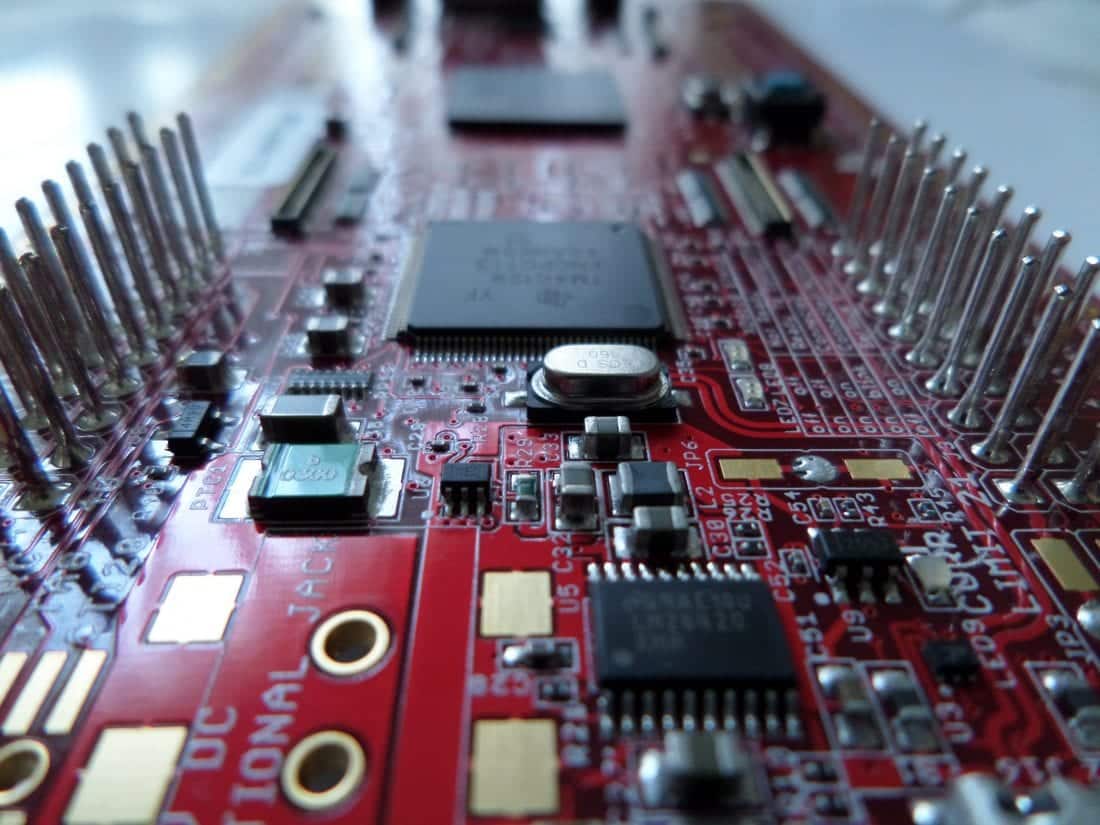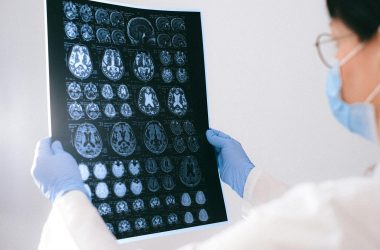By Nicholas Brown – Follow me on Twitter.
The use of acronyms is common in the electrical engineering industry to describe many different electronic parts, phenomenons, and metrics. This page contains electronics acronyms and their meanings.

Image credit: Kompulsa.
- A: Ampere. — A unit of electric current.
- AC: Alternating Current — Electric current that reverses direction periodically.
- AM: Amplitude Modulation.
- AMOLED: Active Matrix Organic LED. A display technology commonly used in phones.
- AGM: Absorbed Glass Mat — This is a form of lead-acid battery.
- ATA: Advanced Technology Attachment. A family of interfaces for connecting computer drives.
- AWG: American Wire Gauge. A measure of wire thickness.
- ALU: Arithmetic Logic Unit.
- APU: Accelerated Processing Unit. A type of processor used in some computers (usually AMD).
- ADC: Analog-To-Digital Converter. ADCs convert analog signals to digital. Needed for software to process or store analog sensor data.
- BAW (resonator): Bulk Acoustic Wave. An alternative to crystal oscillators for clocking.
- BJT: Bipolar Junction Transistor (Bipolar transistor). Common examples: 2n3055 or TIP122.
- BLDC: Brushless Direct Current motor (Brushless DC electric motor).
- BGA: Ball Grid Array. A type of case used when manufacturing integrated circuits.
- C: Capacitor.
- CAN: Controller Area Network. Some microcontrollers use this (often called a CAN bus) to communicate with each other.
- CCD: Charge-Coupled Device.
- CMOS: Complementary Metal-Oxide Semiconductor.
- CPU: Central Processing Unit.
- CRT: Cathode-Ray Tube: The device that powers CRT monitors, TVs, and oscilloscopes.
- DAC: Digital-To-Analog Converter. DAC’s convert digital signals (1s and 0s, so limited to only two states) into analog waveforms (which have more than two states).
- DDR: Double Data Rate.
- DIP: Dual-Inline Package — A specification defining how an integrated circuit’s casing is built/shaped.
- DPDT: Double-Pole Double-Throw. A type of switch (often used in relays and circuit breakers).
- DMA: Direct Memory Access.
- DMM: Digital Multimeter.
- DRAM: Dynamic Random Access Memory.
- DSP: Digital Signal Processor.
- DTL: Diode-Transistor Logic.
- DVI: Digital Visual Interface.
- ECU: Engine Control Unit.
- ECM (electrical): Electronically Commutated Motor, otherwise known as a brushless DC motor.
- ECM (automotive): Engine Control Module (same thing as an ECU).
- EPROM: Erasable Programmable Read-Only Memory.
- EEPROM: Electrically Erasable Programmable Read-only Memory.
- EMAC: Ethernet Media Access Control.
- EMF: Electromotive Force. Another term for voltage.
- EMI: Electromagnetic Interference.
- ESD: Electrostatic Discharge.
- FET: Field-Effect Transistor.
- FLA: Full Load Amperage — How much current an electric motor draws under a full load.
- FM: Frequency Modulation.
- FPGA: Field-Programmable Gate Array.
- GDS: Gas-discharge Tube.
- GND: Ground.
- GPIO: General-Purpose Input/Output.
- GPS: Global Positioning System.
- GPU: Graphics Processing Unit.
- HAL: Hardware Abstraction Layer.
- HDD: Hard Disk Drive.
- HDMI: High-Definition Multimedia Interface.
- IC: Integrated Circuit.
- IGBT: Insulated-Gate Bipolar Transistor.
- ISA: Instruction Set Architecture.
- JFET: Junction Field-Effect Transistor.
- KVA: Kilovolt Amperes.
- L: Inductor.
- LCD: Liquid Crystal Display.
- LED: Light-Emitting Diode.
- LiCoO2: Lithium Cobalt Oxide. A battery chemistry used to power some laptops.
- LiFePO4: Lithium-iron Phosphate. A battery chemistry used to power electric vehicles.
- LiPo: Lithium Polymer. A battery chemistry commonly used to power high-end smartphones due to its high energy density.
- LPF: Low-pass Filter. A filter that allows signals below a certain frequency to pass through, but blocks higher frequency signals.
- LRA: Locked Rotor Amperage — The amount of current drawn by an electric motor if its rotor is jammed.
- MDAC: Multiplying Digital-To-Analog Converter.
- MCU: Microcontroller Unit (common examples: Arduino Uno or Texas Instruments MSP430).
- MMU: Memory Management Unit.
- MOSFET: Metal-Oxide-Semiconductor Field-Effect Transistor.
- MOV: Metal-Oxide Varistor. A resistor used to automatically inhibit overvoltage and surges.
- MUX: Multiplexer.
- NiCd: Nickel-Cadmium. A battery chemistry that used to power laptops, CD players, and other small electronics.
- NiMH: Nickel-Metal Hydride. A battery chemistry that used to be common in hybrid cars and cordless phones.
- NMR: Nuclear Magnetic Resonance.
- NTC: Negative-Temperature Coefficient.
- NVM: Non-volatile Memory.
- NVMe: NVM Express.
- NVRAM: Non-Volatile RAM.
- OLED: Organic LED. A film of organic material that generates light when electrified.
- Op-amp: Operational amplifier.
- PATA: Parallel ATA. An interface used by computer hard drives (among other types of drives) in the 80s, 90s, and early 2000s.
- PCB: Printed Circuit Board.
- PCI: Peripheral Component Interconnect. A bus used to connect peripherals to a computer motherboard (eg. video card).
- PCIe: PCI Express.
- PLC: Programmable Logic Controller. A computer (more of a controller) designed for use in industrial environments.
- PLCC: Plastic Leaded Chip Carrier.
- PROM: Programmable Read-only Memory.
- PSU: Power Supply Unit. Commonly used to refer to the AC To DC power supply found in PCs.
- PTC: Positive Temperature Coefficient. Sometimes used to refer to resistors that increase resistance with temperature to inhibit overvoltage and power surges.
- PWM: Pulse-Width Modulation.
- RAM: Random Access Memory.
- ROM: Read-only Memory.
- RISC: Reduced Instruction Set Computer.
- RTC: Real-time Clock. A clock used for timers in computers and microcontrollers.
- RTL: Resistor-Transistor Logic.
- SATA: Serial ATA. An interface used by computer drives, starting from the early 2000s.
- SBC: Single-Board Computer (common examples: Raspberry Pi and Beaglebone Black).
- SCSI: Small Computer System Interface.
- SLA: Sealed Lead Acid. The sealed variety of lead-acid batteries.
- SPST: Single-Pole Single-Throw. A type of switch or relay.
- SRAM: Static Random Access Memory — An extremely fast type of memory used for caching.
- SSD: Solid-State Drive. A data storage medium with no moving parts.
- TCU: Transmission Control Unit. This device controls the behaviour of automatic vehicle transmissions.
- TCM: Transmission Control Module.
- USB: Universal Serial Bus.
- VRLA: Valve Regulated Lead-Acid (battery).




